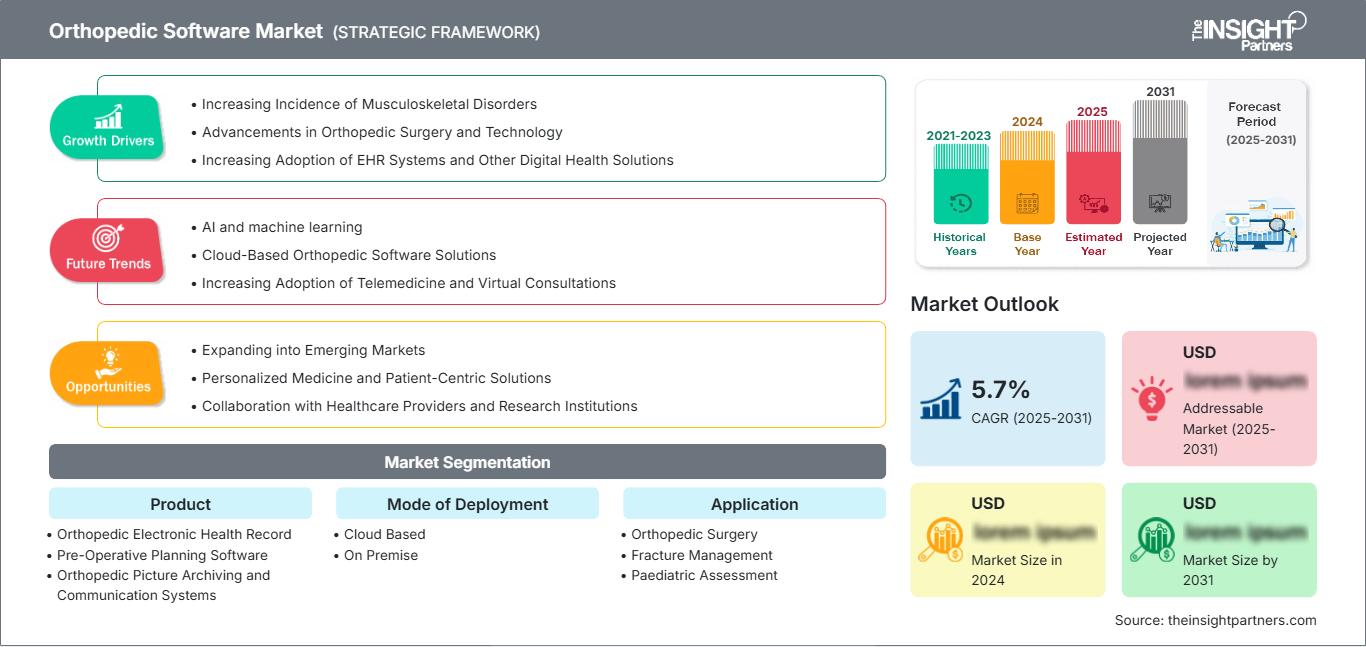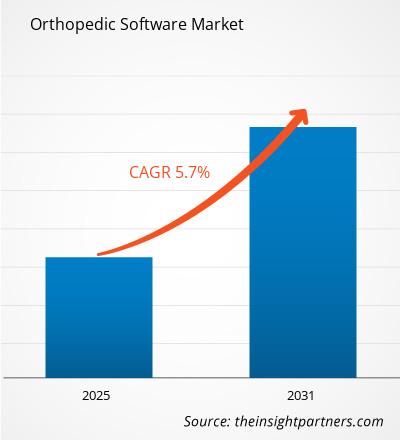The Orthopedic Software Market size is expected to reach US$ 691.1 million by 2031. The market is anticipated to register a CAGR of 6.8% during 2025-2031.
The Orthopedic Software Market report provides an elaborate analysis of Orthopedic Software Market by Software Type, Application, Delivery Channel, and End-user. Regional segmentation of top markets in major nations and global perspective. The values in US$, CAGR forecasts and regional-level analysis of markets by end-user segments and regions is offered along with the market share and market size estimates.
Purpose of the Report
The report Orthopedic Software Market by The Insight Partners aims to describe the present landscape and future growth, top driving factors, challenges, and opportunities. This will provide insights to various business stakeholders, such as:
- Technology Providers/Manufacturers: To understand the evolving market dynamics and know the potential growth opportunities, enabling them to make informed strategic decisions.
- Investors: To conduct a comprehensive trend analysis regarding the market growth rate, market financial projections, and opportunities that exist across the value chain.
- Regulatory bodies: To regulate policies and police activities in the market with the aim of minimizing abuse, preserving investor trust and confidence, and upholding the integrity and stability of the market.
Orthopedic Software Market Segmentation Product
- Orthopedic Electronic Health Record
- Pre-Operative Planning Software
- Orthopedic Picture Archiving and Communication Systems
- Orthopedic Revenue Cycle Management
- Orthopedic Practice Management
Mode of Deployment
- Cloud Based
- On Premise
Application
- Orthopedic Surgery
- Fracture Management
- Paediatric Assessment
Geography
- North America
- Europe
- Asia-Pacific
- South and Central America
- Middle East and Africa
You will get customization on any report - free of charge - including parts of this report, or country-level analysis, Excel Data pack, as well as avail great offers and discounts for start-ups & universities
Orthopedic Software Market: Strategic Insights

-
Get Top Key Market Trends of this report.This FREE sample will include data analysis, ranging from market trends to estimates and forecasts.
Orthopedic Software Market Growth Drivers
- Increasing Incidence of Musculoskeletal Disorders: The increase in the incidence of musculoskeletal disorders such as osteoarthritis, rheumatoid arthritis, and disorders of the spine acts as a key driver for the orthopedic software market. In line with growing incidences of these diseases, there is rising demand for orthopedic treatments related to an aging population. This trend, in turn, has augmented the demand for digital solutions for diagnosis, planning, and surgery in orthopedic treatments. WHO estimates that by 2050, 20% of the world's population will be 60 years or older. As this happens, demand for orthopedic care and software to enhance better treatment outcomes will rise astronomically.
- Advancements in Orthopedic Surgery and Technology: Robotic surgery, 3D printing, and augmented reality are taking orthopedics even further into the future. Such advanced software solutions provide for planning, simulation, and real-time monitoring with such innovations. This adoption of technologies adds to the growth in this market segment. The U.S. NIH reports that 3D printing in orthopedic surgery is growing by 45% every year, creating a very high demand for specialized software supporting such advances.
- Increasing Adoption of EHR Systems and Other Digital Health Solutions: The rise in the adoption of EHR systems along with other digital health solutions has lately opened up a huge market for orthopedic software. Using these systems, orthopedic surgeons can access information on patients, reduce manual tasks, and thus facilitate treatment outcomes. Healthcare IT News reports that more than 70 percent of the hospitals in the U.S. have implemented EHR systems, which in turn creates a strong requirement for orthopedic-specific software applications to integrate with these systems.
Orthopedic Software Market Future Trends
- AI and machine learning: AI and ML make indispensable parts of orthopaedic software, which helps to diagnose patients more precisely, builds personalized treatment paths, and predicts further outcomes. Thus, AI algorithms help in the analysis of data from imaginal records, predict the results of surgeries, and partly take part in post-surgical rehabilitation. A recent estimate by Accenture had projected that with the inclusion of AI applications in healthcare, savings would reach over $150 billion annually by 2026, thereby further fueling market adoption of AI-powered orthopedic software.
- Cloud-Based Orthopedic Software Solutions:
One of the striking trends in the orthopedic software market is moving toward cloud-based software. The benefits that cloud solutions offer to users include real-time access to data, affordability, scalability, and facilitating collaboration across multidisciplinary teams. This trend is helping orthopedic clinics and hospitals to manage operational efficiency. - Increasing Adoption of Telemedicine and Virtual Consultations: The COVID-19 pandemic accelerated the adoption of telemedicine, including in orthopedics. Virtual consultations, remote monitoring, and tele-rehabilitation services are fast becoming indispensable services within the orthopedic care provision, thus compelling the need for specialized software to support such services.
Orthopedic Software Market Opportunities
- Expanding into Emerging Markets: The emerging markets of the Asia-Pacific, Latin America, and the Middle East carry a great potential for the orthopedic software market. In addition, the improving infrastructure of healthcare and rising expenditure on healthcare will continue to encourage advanced orthopedic solutions within these regions.
According to the World Bank, spending on health care in the Asia-Pacific region is growing by an average of 7% per year. This may be one of the reasons why orthopaedic software applications are finding increased favor in these rapidly developing regions. - Personalized Medicine and Patient-Centric Solutions: There is an increasing demand for personalized healthcare solutions. Changes are taking place in orthopaedic software, too, to meet the trend of personalized treatment with data on a patient's genetic profile, lifestyle, and treatment history. Personalized software solutions can thus help in better patient outcomes and efficient utilization of resources at an orthopedic clinic.
- Collaboration with Healthcare Providers and Research Institutions: Collaboration by orthopedic software companies, healthcare providers, and research institutions is opening up new avenues of opportunity in product development and enhancement of treatment methods. Under these partnerships, next-generation software solutions will integrate surgical planning and recovery monitoring with rehabilitation services.Report Scope
Orthopedic Software Market Regional Insights
The regional trends and factors influencing the Orthopedic Software Market throughout the forecast period have been thoroughly explained by the analysts at The Insight Partners. This section also discusses Orthopedic Software Market segments and geography across North America, Europe, Asia Pacific, Middle East and Africa, and South and Central America.
Orthopedic Software Market Report Scope
By Mode of Deployment- Cloud Based
- On Premise
- Orthopedic Surgery
- Fracture Management
- Paediatric Assessment
- UK
- Germany
- France
- Russia
- Italy
- Rest of Europe
- China
- India
- Japan
- Australia
- Rest of Asia-Pacific
- Brazil
- Argentina
- Rest of South and Central America
- South Africa
- Saudi Arabia
- UAE
- Rest of Middle East and Africa
Report Attribute Details Market size in 2024 US$ XX Million Market Size by 2031 US$ 691.1 Million Global CAGR (2025 - 2031) 6.8% Historical Data 2021-2023 Forecast period 2025-2031 Segments Covered By Product - Orthopedic Electronic Health Record
- Pre-Operative Planning Software
- Orthopedic Picture Archiving and Communication Systems
- Orthopedic Revenue Cycle Management
- Orthopedic Practice Management
Regions and Countries Covered North America - US
- Canada
- Mexico
Market leaders and key company profiles - Athena Health
- Brainlab AG
- DrChrono Inc
- CureMD Healthcare
- Allscripts Healthcare, LLC
- Greenway Health LLC
- IBM
- Materialise
- Medstrat Inc.
Orthopedic Software Market Players Density: Understanding Its Impact on Business Dynamics
The Orthopedic Software Market is growing rapidly, driven by increasing end-user demand due to factors such as evolving consumer preferences, technological advancements, and greater awareness of the product's benefits. As demand rises, businesses are expanding their offerings, innovating to meet consumer needs, and capitalizing on emerging trends, which further fuels market growth.

- Get the Orthopedic Software Market top key players overview
Frequently Asked Questions
Which are key players in the Orthopedic Software Market?
What are the deliverable formats of the Orthopedic Software Market report?
What are the options available for the customization of this report?
What is expected CAGR in Orthopedic Software Market?
What are the factors impacting on the Orthopedic Software Market?
What are the future trends in the Orthopedic Software Market?
- Historical Analysis (2 Years), Base Year, Forecast (7 Years) with CAGR
- PEST and SWOT Analysis
- Market Size Value / Volume - Global, Regional, Country
- Industry and Competitive Landscape
- Excel Dataset
Recent Reports
Related Reports
Testimonials
Reason to Buy
- Informed Decision-Making
- Understanding Market Dynamics
- Competitive Analysis
- Identifying Emerging Markets
- Customer Insights
- Market Forecasts
- Risk Mitigation
- Boosting Operational Efficiency
- Strategic Planning
- Investment Justification
- Tracking Industry Innovations
- Aligning with Regulatory Trends





















 Get Free Sample For
Get Free Sample For